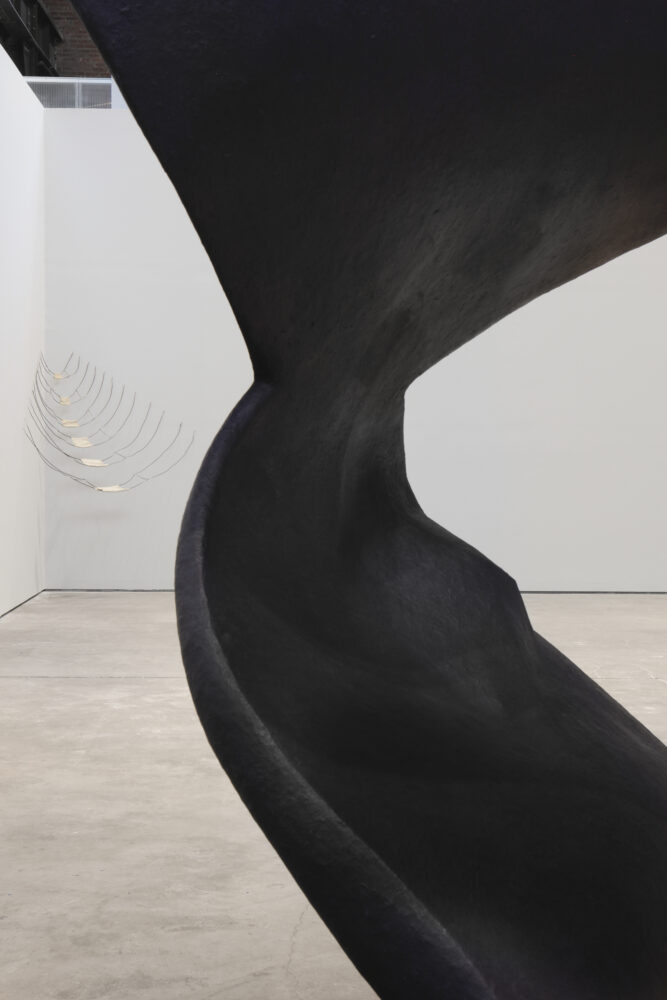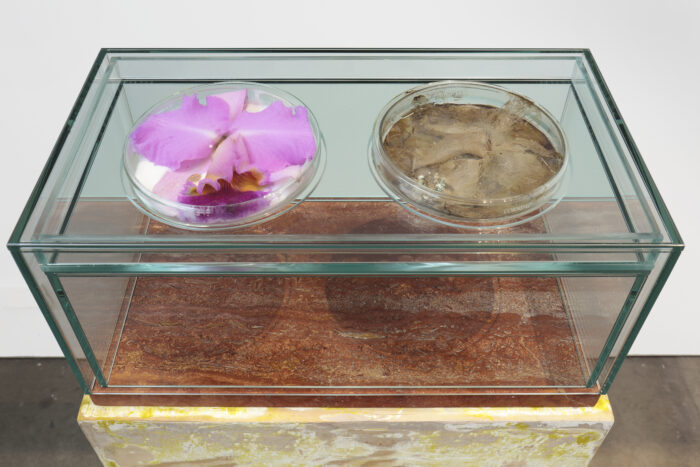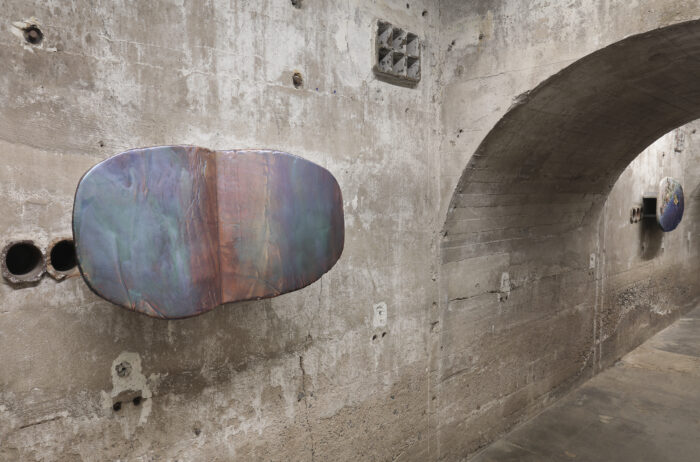










x 40.6 x 203.2 cm). Walker Art Center, Minneapolis. T. B. Walker Acquisition Fund
Liz Larner: Don’t put it back like it was at
Organized by SculptureCenter, New York, and the Walker Art Center, Minneapolis
January 20 – March 28, 2022
Los Angeles-based artist Liz Larner, one of the most influential artists of her generation, has explored the material and social possibilities of sculpture in innovative and surprising ways over the past three decades. Liz Larner: Don’t put it back like it was is organized by SculptureCenter, New York, and the Walker Art Center, Minneapolis. The exhibition will be the artist’s largest survey since 2001 and will reposition Larner’s enduring formal and material concerns alongside her relationship to a feminist sculptural position.
Presenting approximately thirty works produced between 1987 and 2021, the exhibition offers an opportunity to view Larner’s larger artistic project within today’s expanded discourses of embodiment, gender, and posthumanism, and to recalibrate our understanding of it in relation to male-dominated postminimalism and installation art, which have often underpinned Larner’s critical reception.
Larner’s use of materials ranges from the traditional—such as bronze, porcelain, glass, or stainless steel—to the unexpected: volcanic ash, surgical gauze, leather, or eyelashes, each medium selected for its physical or chemical properties as well as for social and historical associations. Responsive to the characteristics of these materials, her works can be delicate or aggressive; meticulously crafted or unruly and formless.
Featured works include the artist’s early experiments with bacterial cultures and destructive machines, installations that respond to architecture, sculptures that reconsider figuration, and more recent wall-based works in ceramic. As a whole, the exhibition underscores the power and intention of Larner’s work to reconsider objects in physical space as not only a matter of architectural proportions, but also as social constructions. The experience of viewing them compels an awareness of our own embodied presence and how we understand ourselves as human subjects in relationship to other objects and to space in general.
The exhibition examines ways in which Larner has investigated both the material potential of sculpture and its ability to reflect the relative social and physical positions of its viewers, bringing forward key themes that have occupied the artist’s work: the dynamic between power and instability; the tension between surface and form; and the interconnectedness of objects to our bodies. Works such as Corner Basher (1988) and Orchid, Buttermilk, Penny (1987) call up destruction and decay as creative forces. Sculptures made in pliable fabric or metal, such as Bird in Space (1989) or Guest (2004) physically adapt to and alter our perception of the architectural spaces in which they are exhibited. 2 as 3 and Some, Too (1997-98)—made from mulberry paper, steel and watercolor—resembles two interlocking cubes, but, like a freehand drawing, its lines have collapsed and softened into a relaxed form that resists rigid geometry and perceived stability. V (planchette) (2013), a pinched and twisted aluminum form covered in painted paper, appears to shapeshift as we move around it. The exhibition also includes a selection of Larner’s more recent ceramic works of the past decade, in which she has embraced the unpredictability in the processes of shaping, firing, and glazing to create surfaces that allude to both landscape and abstraction.
The exhibition is accompanied by a fully-illustrated catalog, published by Dancing Foxes Press and including contributions by exhibition curator Mary Ceruti; Connie Butler, chief curator at the Hammer Museum, Los Angeles; and poet, playwright, and performance artist Ariana Reines.
Liz Larner: Don’t put it back like it was is curated by Mary Ceruti, Executive Director, Walker Art Center. The New York presentation is curated by Kyle Dancewicz, Interim Director, SculptureCenter.
The SculptureCenter presentation of Liz Larner: Don’t put it back like it was is made possible with the support of the Henry Moore Foundation. Support for the publication is provided in part by Galerie Max Hetzler, Berlin | Paris | London; The Modern Institute, Glasgow; and Regen Projects, Los Angeles.
Tour Details
Tour DetailsTour dates:
SculptureCenter, New York
January 20–March 28, 2022
Walker Art Center, Minneapolis
April 30–September 4, 2022
About Liz Larner
Liz Larner (born 1960 in Sacramento; lives and works in Los Angeles) has exhibited extensively since the late 1980s. Recently, she has presented solo exhibitions at Galerie Max Hetzler, Paris (2017); Galerie Max Hetzler, Berlin (2016); Aspen Art Museum (2016); Art Institute of Chicago (2015); The Modern Institute, Glasgow (2015); and Regen Projects, Los Angeles (2014). In addition, her work has recently been included in group shows at the Hammer Museum, Los Angeles (2017); The Modern Institute, Glasgow (2017); DePaul Art Museum, Chicago (2016); Redling Fine Art, Los Angeles (2016); Hauser Wirth & Schimmel, Los Angeles (2016); Museum of Contemporary Art, Los Angeles (2015); Hirshhorn Museum and Sculpture Garden, Washington, D.C. (2013); and Nasher Sculpture Center, Dallas (2013).
About SculptureCenter
SculptureCenter leads the conversation on contemporary art by supporting artistic innovation and independent thought highlighting sculpture’s specific potential to change the way we engage with the world. Positioning artists’ work in larger cultural, historical, and aesthetic contexts, SculptureCenter discerns and interprets emerging ideas. Founded by artists in 1928, SculptureCenter provides an international forum that connects artists and audiences by presenting exhibitions, commissioning new work, and generating scholarship.
Since relocating to Long Island City in 2001, SculptureCenter has presented works by over nine hundred artists through its annual exhibition program, and today, it is considered one of New York’s most important kunsthalles. Placing emphasis on investment, inclusiveness, independence, transparency, and rigor, SculptureCenter has developed a strong reputation for championing underrecognized and emerging artists, many of whom have gone on to celebrated and substantial careers; these include Nairy Baghramian, Sanford Biggers, Tom Burr, Liz Glynn, Rochelle Goldberg, Leslie Hewitt, Tishan Hsu, Rashid Johnson, Rindon Johnson, Ugo Rondinone, Gedi Sibony, Alexandre Singh, Monika Sosnowska, Mika Tajima, Jesse Wine, Turner Prize winner Charlotte Prodger and nominee Anthea Hamilton, and Hugo Boss Prize winners Anicka Yi and Simone Leigh. SculptureCenter continuously offers a dynamic series of free public programs and events including artist talks, performances, film screenings, and publications.
Leadership support of SculptureCenter’s exhibitions and programs is provided by Carol Bove, Jill and Peter Kraus, The Pollock-Krasner Foundation, Lee Elliott and Robert K. Elliott, Eleanor Heyman Propp, Miyoung Lee and Neil Simpkins, Jacques Louis Vidal, and Robert Soros and Jamie Singer Soros and the Andy Warhol Foundation for the Visual Arts.
SculptureCenter’s annual operating support is provided by the Elaine Graham Weitzen Foundation for Fine Arts; the Lambent Foundation Fund of Tides Foundation; the Anna-Maria and Stephen Kellen Foundation; A. Woodner Fund; Libby and Adrian Ellis; The Willem de Kooning Foundation; Teiger Foundation; Helen Frankenthaler Foundation; Cy Twombly Foundation; Arison Arts Foundation; public funds from the New York City Department of Cultural Affairs in partnership with the City Council; the New York State Council on the Arts and the New York State Legislature; and contributions from our Board of Trustees, Director’s Circle, SC Ambassadors, and many generous individuals and friends.
